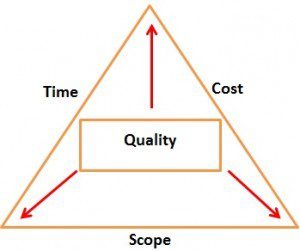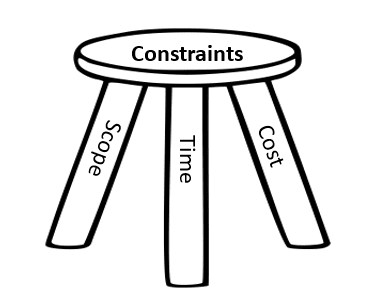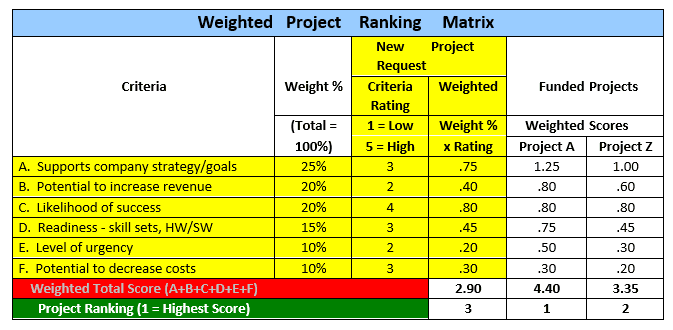 Introduction
Introduction
Most courses and books on project management discuss the “Triple Constraints” in terms of a three-legged stool (see Figure 1 below). The first leg represents Scope Management, the second, Time Management, and the third, Cost Management. If one aspect is shortened or increased in length, then the two other “legs” must be adjusted accordingly for a successful project. For example, if you increase scope, it will influence time and cost. Balancing the triple constraints is a lot like juggling. It’s also a constant reminder of how changing one constraint will cast an impact on the entire project.
I have been working in project management for over four decades, and I’ve have observed at least two dozen projects that met the scope, cost, and time goals without being considered successful by the sponsor/customer. Why? There are many factors (resources, communications, procurement, risk, and quality are a few) that can lead to this situation, but most of the time, it was the lack of quality being “baked” into the final service or product. Some people, including myself, believe the triple constraints should be expanded into quadruple constraints, including quality with the aspects of scope, time, and cost. The bottom line is having and meeting quality standards is a key factor in obtaining customer or sponsor satisfaction. It’s likely that this desire for quality was the primary reason why the project was undertaken, in the first place, so why shouldn’t it be just as important as time, scope, and cost?!
Quality Management
One of the principles of quality management (QM) is that it’s customer oriented. It’s also made up of two key parts: quality assurance (QA) and quality control (QC). QA is the maintenance of a chosen level of quality in a service or product, especially by means of attention to every stage of the process of delivery. The goal here is to meet the needs and expectations of the customers. This all helps to build trust and loyalty. QC involves inspections, reviews, and evaluations of the various units to determine if they are within the specifications for the final product. This is accomplished through independence, integrity, and objectivity. QA is process oriented, whereas QC is product oriented. Projects should have periodic mini reviews that rate progress against certain defined metrics. Table 1 combines the three types of QM reviews (health, compliance, and deliverable) into one mini review.
Every project should have prescribed quality indicators that can be used for recovery assessment. This includes the level of defects or number of discrepancies in deliverables–first by internal review, and then by the customer. We also want to look at the number of re-work activities following internal and customer reviews. Monitoring all of this on an ongoing basis is essentially part of tracking and controlling project performance.
For software development projects, make sure the end-users or customers are part of the participative development team, so they feel they have ownership of the service or product (this should increase their overall satisfaction). Expect the product requirements to evolve throughout the development process, and continue to validate that the proposed product will be satisfactory to the customer after it is completed and delivered.
Summary
Always try to see quality through the customer’s eyes, and remember it applies to the life of a product and covers all aspects of a product. I have seen several products introduced that had great quality, but the price was unbelievably high because they had a near monopoly on the marketplace. When the product starts to have competition, prices are lowered and companies look to cutting costs to keep profit margins up. This can result in the product’s quality being reduced. I am speculating a possible example of this is Gillette, which once held a 70% market share in US for razor blades. We’ve seen upstarts like Harry’s and Dollar Shave Club (DSC) slice away at Gillette’s customer base over the last decade. While Gillette remains in control, its market share has shrunk down to nearly 50%. A possible lesson to be learned is that if your product is overpriced and/or you ease up your interest in ensuring quality to save costs, your competitors will gladly demonstrate their interest in winning over your customers.
Your thoughts on expanding the triple constraints into the quadruple constraints of project management in the comment section below are appreciated.









